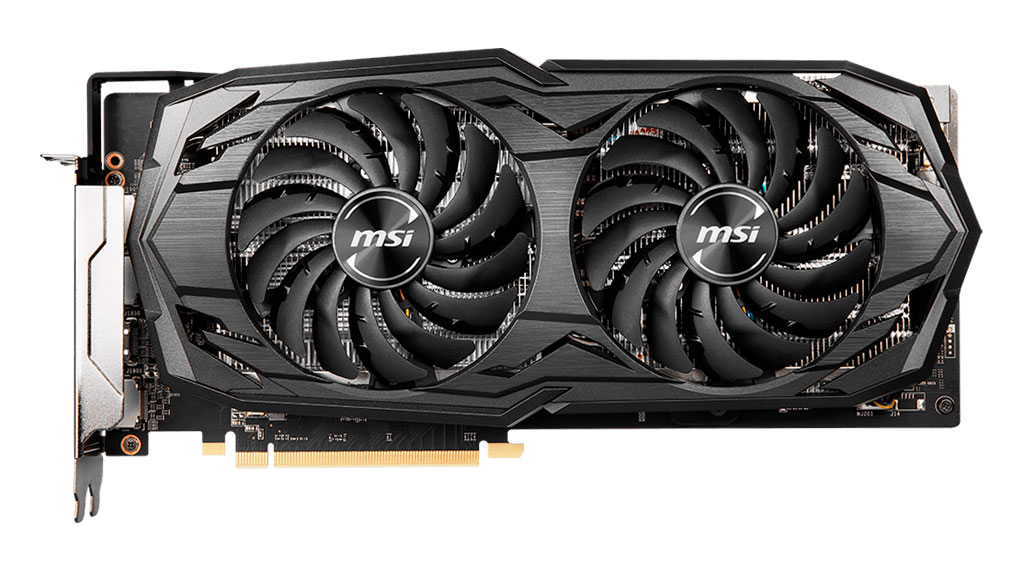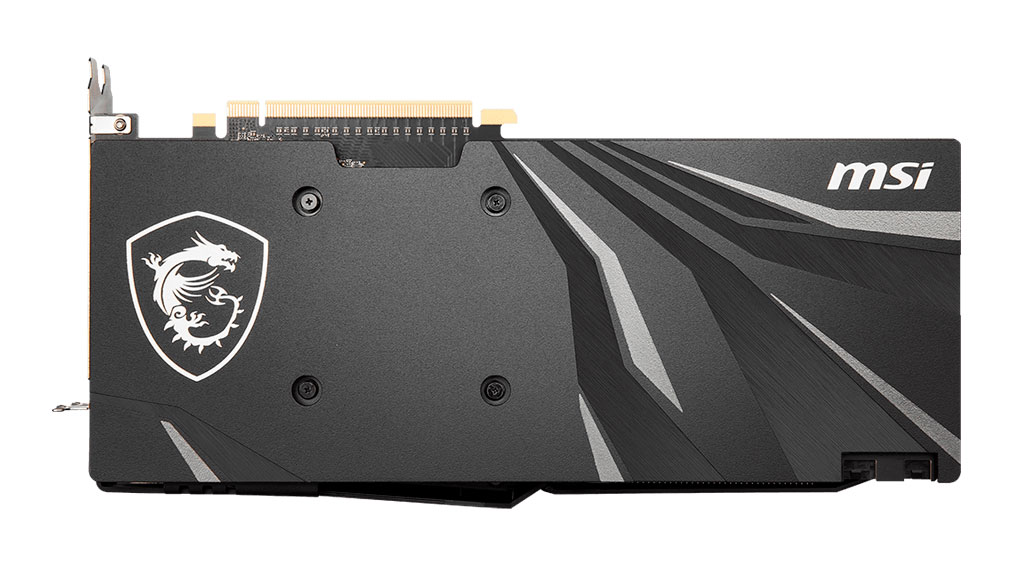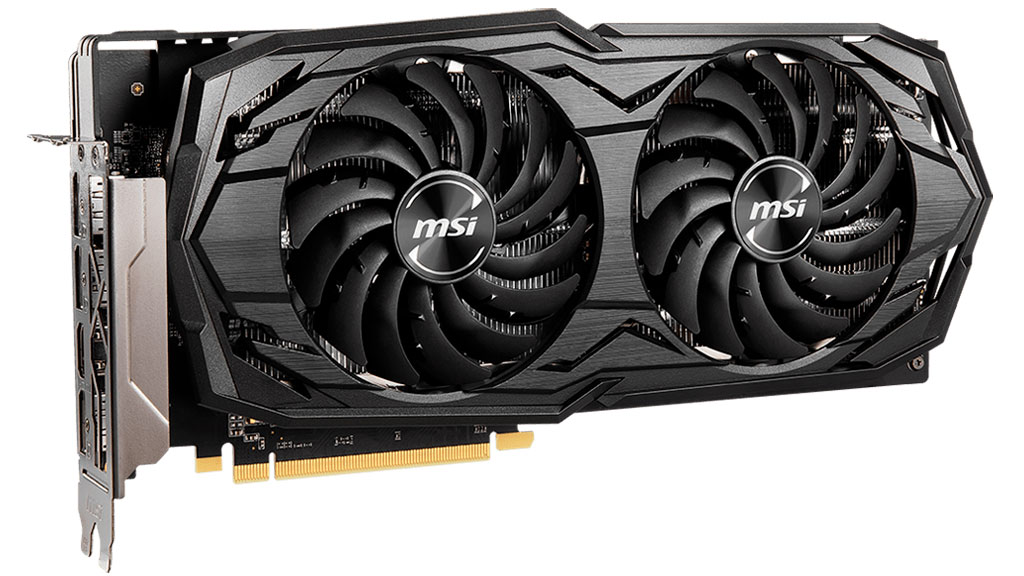AMD Navi 10 on Budget: MSI Outs Radeon RX 5600 XT Gaming MX Graphics Cards
MSI has silently expanded its Radeon RX 5600 XT army with a new series of graphics cards. Given the specifications, the Gaming MX lineup appears to be a budget-oriented version of the Gaming series.
As spotted by VideoCardz, the MSI Radeon RX 5600 XT Gaming MX flexes a dual-slot design built upon a black and iron grey shroud that lacks RGB lighting. Those familiar with MSI's graphics cards may notice that the Gaming M's shroud looks similar to the design on the Armor series. MSI affirms that the Radeon RX 5600 XT M(X) utilizes a custom PCB but doesn't expose the design of the power delivery subsystem. The new graphics card is 297mm long.
A pair of Torx 3.0 cooling fans are in charge of cooling the Radeon RX 5600 XT MX. As opposed to traditional fan blades, Torx 3.0 fan blades feature a curved design to accelerate airflow.
MSI equips the Torx 3.0 fan with its Zero Frozr technology, meaning the fan will remain inactive unless the graphics card's operating temperature breaks 60 degrees Celsius (140 degrees Fahrenheit). Although the Radeon RX 5600 XT MX is supposed to be a low-cost product in MSI's product stack, the manufacturer went ahead and gave the graphics card a slick backplate anyway.


The Radeon RX 5600 XT MX is based on the Navi 10 silicon and brings 2,304 Stream Processors (SPs) along with 6GB of GDDR6 memory.
The Radeon RX 5600 XT MX comes equipped with base, game and boost clocks up to 1,280 MHz, 1,495 MHz and 1,620 MHz, respectively.
MSI has also introduced the Radeon RX 5600 XT Gaming M, which checks in with a 1,130 MHz base clock, 1,375 MHz game clock and 1,560 MHz boost clock.
Get Tom's Hardware's best news and in-depth reviews, straight to your inbox.
One thing the two Gaming M models have in common is memory. The graphics cards each sport 14 Gbps memory that communicates across a 192-bit memory interface. The result is a memory bandwidth that maxes out at 288 GBps.
Display outputs are identical on both models. There are three DisplayPort 1.4 outputs and one HDMI 2.0b port. The Radeon RX 5600 XT Gaming M(X) requires two 8-pin PCIe power connectors. The graphics card is rated for 150W, so it should run fine with a 450W power supply; however, MSI recommends a 550W unit.
Pricing and availability for the MSI Radeon RX 5600 XT Gaming MX and M are unknown at the time of writing.

Zhiye Liu is a news editor, memory reviewer, and SSD tester at Tom’s Hardware. Although he loves everything that’s hardware, he has a soft spot for CPUs, GPUs, and RAM.
-
King_V The need for two 8-pin connectors is baffling. A typical RX 5600 XT is about 150W, so, a single 8-pin would be barely enough if it somehow drew ZERO power from the PCIe slot.Reply
Let's say you wanted to stay well below the PCIe max spec for power draw, and refused to pull any more than 50W from it. And, let's say for some reason that these cards, which are NOT highly overclocked, drew 5700 levels of power, so 185W.
That would be 50 from the PCIe, and 135W more from connectors. A single 8-pin is still well more than up to the task. -
InvalidError Reply
Maybe they are doing it a bit like motherboards: the extra connectors are optional for normal use and mainly there to provide somewhere convenient to plug loose ends into instead of leaving them dangling around the case where they may short against something.King_V said:The need for two 8-pin connectors is baffling. -
BaRoMeTrIc ReplyKing_V said:The need for two 8-pin connectors is baffling. A typical RX 5600 XT is about 150W, so, a single 8-pin would be barely enough if it somehow drew ZERO power from the PCIe slot.
Let's say you wanted to stay well below the PCIe max spec for power draw, and refused to pull any more than 50W from it. And, let's say for some reason that these cards, which are NOT highly overclocked, drew 5700 levels of power, so 185W.
That would be 50 from the PCIe, and 135W more from connectors. A single 8-pin is still well more than up to the task.
150 is probably a average use case, AMD doesnt draw much juice from the 3.3v rail on the pcie, so like you said that leaves them with 50w from the 12v rail, probably just spreading it out over the pcie to keep the amps down to maintain efficiency. but under load at that clock speed and memory speed i'm sure it's capable of hitting 200+ -
vinay2070 Reply
I have a Gigabyte GTX 1080 OC card, which has just a single 8 pin power connector which I have overclocked decently. Pulls 220 Watts as per hwinfo. No issues so far. 2 X 8 pin is overkill.King_V said:The need for two 8-pin connectors is baffling. A typical RX 5600 XT is about 150W, so, a single 8-pin would be barely enough if it somehow drew ZERO power from the PCIe slot.
Let's say you wanted to stay well below the PCIe max spec for power draw, and refused to pull any more than 50W from it. And, let's say for some reason that these cards, which are NOT highly overclocked, drew 5700 levels of power, so 185W.
That would be 50 from the PCIe, and 135W more from connectors. A single 8-pin is still well more than up to the task. -
InvalidError Reply
It really is. The spec for the low-current MiniFitJr pins is 9A a piece (13A for the high-current variants) so an 8-pin connector with one 12V line dedicated to remote Vsense would still be good for up to 27A which is roughly 300W at 12V. The PCIe-SIG was being excessively conservative by speccing 6/8-pin PCIe AUX connectors to only 75W and 150W respectively. You'd need to be running #26 wires from the PSU to need this many pins for 150W and the worst PSUs I have seen still use at least #20. The PCIe-SIG spec appears effectively predicated on people using Molex/SATA-to-PCIe adapters.vinay2070 said:2 X 8 pin is overkill. -
King_V Reply
200+? How do you figure that?BaRoMeTrIc said:150 is probably a average use case, AMD doesnt draw much juice from the 3.3v rail on the pcie, so like you said that leaves them with 50w from the 12v rail, probably just spreading it out over the pcie to keep the amps down to maintain efficiency. but under load at that clock speed and memory speed i'm sure it's capable of hitting 200+ -
BaRoMeTrIc Reply
I figure that by the numerous tests done on the 5600xt 14gbps that shows it pulls 198-210 under full load with max boost clocksKing_V said:200+? How do you figure that?
https://www.anandtech.com/show/15422/the-amd-radeon-rx-5600-xt-review/16
unless you want to scour the internet to find some geocities site to prove your point. -
King_V That's TOTAL system power if you look at the description on Anandtech's graph.Reply
The M and MX are meant to be budget cards. They have fairly low clock rates.
And, if you look, and cut out the snarkiness, you don't have to find it "at some Geocities site," but Tom's Hardware reviewed both the reference and the Sapphire Pulse OC with the updated BIOS.
Looking at the power charts, we compared the Sapphire 5600 XT Pulse OC with its reference configuration as well as the OC bios. We saw significant differences between them. Where the reference card peaked at 121W, averaging around 110W, with the new BIOS it peaked at 156W while averaging 140W. Quite a difference, but still averaging well under the listed board power (160W in the case of the Pulse OC).
https://www.tomshardware.com/reviews/amd-radeon-rx_5600_xt/4
So, the card itself is NOT drawing 200+ watts. Not even close. Even the Sapphire Pulse OC could get by easily on a single 8-pin, peaking at 156W. -
ProLifeWillWinIn2020 I'm not complaining about the two 8 pin connection because one of my 600 watt power supply supports it but my 700 watt one doesn't so I'll have to swap my power supply. I'm just intrigued on why it would need this type of power. Is there something special about this 5600 xt 6gb model that would indicate that there might be more power under the hood than most realize? If that's the case it's a steal right now at 239.99 after 20 dollar rebate on newegg. Heck I think it's a great deal either way. However if it has more power because of having two 8 pin connection requirement that would be awesome and even more value. I do know this card is still fairly new so for all we know maybe in future bios updates it could possibly get even better?Reply
